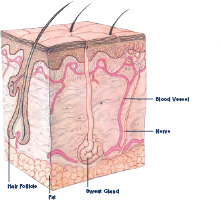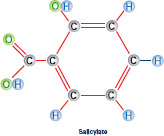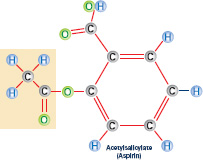2.2: River of Life
- Page ID
- 211469
Using Achem Glossary
Analytical Chemistry, Transition Metal, Carbocation, Infrared Spectroscopy
Since blood is the body's primary internal transportation system, most drugs travel via this route. Medicines can find their way to the bloodstream in several ways, including the rich supply of blood vessels in the skin. You may remember, as a young child, the horror of seeing blood escaping your body through a skinned knee. You now know that the simplistic notion of skin literally "holding everything inside" isn't quite right. You survived the scrape just fine because blood contains magical molecules that can make a clot form within minutes after your tumble. Blood is a rich concoction containing oxygen-carrying red blood cells and infection-fighting white blood cells. Blood cells are suspended in a watery liquid called plasma that contains clotting proteins, electrolytes, and many other important molecules.
Burns: More Than Skin Deep
More than simply a protective covering, skin is a highly dynamic network of cells, nerves, and blood vessels. Skin plays an important role in preserving fluid balance and in regulating body temperature and sensation. Immune cells in skin help the body prevent and fight disease. When you get burned, all of these protections are in jeopardy. Burn-induced skin loss can give bacteria and other microorganisms easy access to the nutrient-rich fluids that course through the body, while at the same time allowing these fluids to leak out rapidly. Enough fluid loss can thrust a burn or trauma patient into shock, so doctors must replenish skin lost to severe burns as quickly as possible.
In the case of burns covering a significant portion of the body, surgeons must do two things fast: strip off the burned skin, then cover the unprotected underlying tissue. These important steps in the immediate care of a burn patient took scientists decades to figure out, as they performed carefully conducted experiments on how the body responds to burn injury. In the early 1980s, researchers doing this work developed the first version of an artificial skin covering called Integra® Dermal Regeneration Template™, which doctors use to drape over the area where the burned skin has been removed. Today, Integra Dermal Regeneration Template is used to treat burn patients throughout the world.
Blood also ferries proteins and hormones such as insulin and estrogen, nutrient molecules of various kinds, and carbon dioxide and other waste products destined to exit the body.
While the bloodstream would seem like a quick way to get a needed medicine to a diseased organ, one of the biggest problems is getting the medicine to the correct organ. In many case, drugs and up where they are not needed and cause side effects, as we've already noted. What's more, drugs may encounter many different obstacles while journeying through the bloodstream. Some medicines get "lost" when they stick tightly to certain proteins in the blood, effectively putting the drugs out of business.
Scientists called physiologists originally came up with the idea that all internal processes work together to keep the body in a balanced state. The bloodstream links all our organs together, enabling them to work in a coordinated way. Two organ systems are particularly interesting to pharmacologists: the nervous system (which transmits electrical signals over wide distances) and the endocrine system (which communicates messages via traveling hormones). These two systems are key targets for medicines.

Skin consists of three layers, making up a dynamic network of cells, nerves, and blood vessels.


Acetylsalicylate is the aspirin of today. Adding a chemical tag called an acetyl group (shaded yellow box, right) to a molecule derived from willow bark (salicylate, above) makes the molecule less acidic (and easier on the lining of the digestive tract), but still effective at relieving pain.

